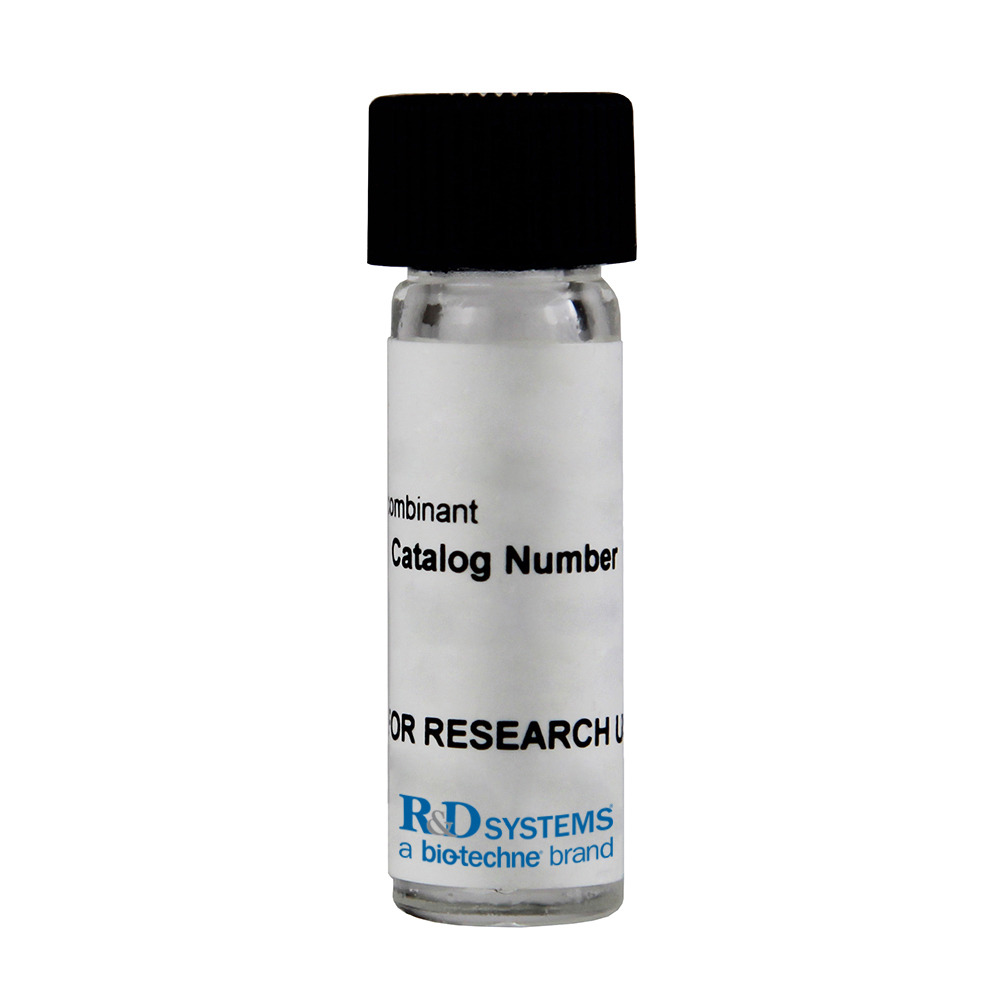Recombinant Mouse CCL7/MARC Protein
R&D Systems, part of Bio-Techne | Catalog # 456-MC

Key Product Details
Product Specifications
Source
Gln24-Pro97
Purity
Endotoxin Level
N-terminal Sequence Analysis
Predicted Molecular Mass
Activity
The ED50 for this effect is 0.1-0.3 µg/mL.
Measured by its ability to chemoattract BaF3 mouse pro-B cells transfected with human CCR2A.
The ED50 for this effect is 0.5-2 µg/mL.
Reviewed Applications
Read 1 review rated 5 using 456-MC in the following applications:
Formulation, Preparation and Storage
Carrier Free
What does CF mean?CF stands for Carrier Free (CF). We typically add Bovine Serum Albumin (BSA) as a carrier protein to our recombinant proteins. Adding a carrier protein enhances protein stability, increases shelf-life, and allows the recombinant protein to be stored at a more dilute concentration. The carrier free version does not contain BSA.
What formulation is right for me?In general, we advise purchasing the recombinant protein with BSA for use in cell or tissue culture, or as an ELISA standard. In contrast, the carrier free protein is recommended for applications, in which the presence of BSA could interfere.
Carrier: 456-MC
| Formulation | Lyophilized from a 0.2 μm filtered solution in Acetonitrile and TFA with BSA as a carrier protein. |
| Reconstitution | Reconstitute at 100 μg/mL in sterile, deionized water. |
| Shipping | The product is shipped at ambient temperature. Upon receipt, store it immediately at the temperature recommended below. |
| Stability & Storage | Use a manual defrost freezer and avoid repeated freeze-thaw cycles.
|
Carrier Free: 456-MC/CF
| Formulation | Lyophilized from a 0.2 μm filtered solution in Acetonitrile and TFA. |
| Reconstitution | Reconstitute at 100 μg/mL in sterile, deionized water. |
| Shipping | The product is shipped at ambient temperature. Upon receipt, store it immediately at the temperature recommended below. |
| Stability & Storage | Use a manual defrost freezer and avoid repeated freeze-thaw cycles.
|
Background: CCL7/MCP-3/MARC
Mouse MARC, a member of the beta subfamily of chemokines, was initially identified as a transcript that is induced in a mouse mast cell line after Fc epsilon RI triggering by IgE plus antigen. Sequence comparisons suggest that MARC may be the mouse homologue of the human MCP-3 gene. Mouse MARC/MCP-3 expression has also been detected during murine experimental allergic encephalomyelitis in the spinal cord, and in LPS-stimulated murine WEHI -3 cells and Swiss 3T3 cells where MARC expression is glucocorticoid-attenuated. Except for one amino acid subsititution, mouse MARC is identical to mouse FIC, the product of a growth factor-activated gene. The mouse MARC cDNA encodes a 97 amino acid residue precursor protein with a 23 amino acid residue signal peptide that is cleaved to yield a 74 amino acid residue mature protein. Mouse CCR2, a mouse chemokine receptor, has been shown to bind JE/MCP-1 with high affinity and MARC/MCP-3 with lower affinity. The E. coli-expressed mouse MARC/MCP-3 produced at R&D Systems has been shown to be a monocyte and T-lymphocyte chemoattractant.
References
- Kulmburg, P.A. et al. (1992) J. Exp. Med. 176:1773.
- Thirion, S. et al. (1994) Biochem. Biophys. Res. Commun. 201:493.
- Smith, J.B. and H.R. Herschman (1995) J. Biol. Chem. 270:16756.
- Kurihara, T. and R. Bravo (1996) J. Biol. Chem. 271:11603.
Alternate Names
Gene Symbol
UniProt
Additional CCL7/MCP-3/MARC Products
Product Documents for Recombinant Mouse CCL7/MARC Protein
Product Specific Notices for Recombinant Mouse CCL7/MARC Protein
For research use only
